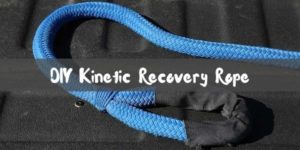Last Updated on August 22, 2022
Kinetic recovery rope has a lot of benefits. It comes in handy when you are stuck in the sand, mud, snow, and water. Another vehicle will help tow your vehicle out by transmitting its kinetic energy to the recovery rope, which in turn transmits to your vehicle. The rope is stretchy, built from nylon from the inside.
What if you are in a situation where you cannot get the ready-made rope because of your location or financial constraints? You can make your own, all by following the great steps we have put down.
Note: I have reviewed some best selling kinetic recovery ropes. Read this review if you need to buy one.
Quick Navigation
DIY Kinetic Recovery Rope Guide

I always prefer nylon and polyester straps, which are easy to get from any hardware store. There are also other materials, which, at your disposal, you can make use of. These materials include polyurethane.
In our leading guide, let’s consider nylon’s use, though you will use the same steps when using alternative materials.
Step 1: Identify the Nylon Grade
Unfortunately, nylon material comes in several grades, which makes it difficult to use one to determine the strength. However, do not worry about this, as there is a way out. You can ask before making the purchase, or, if you already have the straps, enquire from the nearest store.
Once you know the material’s strength, you can determine whether weaving several together will make a strong enough rope for your car.
Step 2: Determine the Weight of the Car
Before starting the weaving process, check the gross weight of your car. The rope should be thrice as stronger, twice at the minimum.
Ensure that you do not exclude any accessories from the car because even the least weight will impact.
Step 3: Determine the Strands You Need
Let’s assume that each of your nylon straps carries a strength of 400 lbs. Thus, the strand would break after handling even a single pound over 400lbs. However, your car weighs 4,000 lbs, which means that the rope should handle a minimum of 8,000 lbs.
So, you will need double the car’s weight, that is, 8,000 lbs divided by the strength of one strap, which is 400 lbs. This will give you 20, which is the number of nylon strands you will weave together.
Step 4: Start Your Braid
Now it’s time to weave together all the twenty strands into each other. If you don’t have a rope weaving background, you can start with a knot on one end.
Subsequently, divide the strands into three sections, with two on each side in seven straps, and the middle section left in six strands.
Start the process by bringing in the right-hand side strands between the middle and the left strands. Then, take the left hand strands and put them in between the middle straps and the righthand straps.
Take the middle straps and place them in between the right and the left straps. Continue in this uniform structure, step by step, until you finally have the last of each section. Complete it and bind the ropes with a knot, unless you have the weaving know-how. You can complete the straps with a design of your choice, which is more intricate and less bulky if you do.
Step 5: Form the Loops
Each side of the rope should have a loop, which will hold to the shackle that connects the rope to the two vehicles.
Fold the rope on each side into a small loop, only enough to handle the vehicle towing shackle. How do you form tight loops? Tuck each of the three strands into a hole you will create in the rope, pulling them to the other side and ensuring that they form a tight loop.
Step 6: Get the Shackles
Now you will need strong shackles, which you will attach to the vehicles. Put the rope loops in the shackles and start your trials.
Why DIY Kinetic Recovery Rope?
In most cases, DIY allows you to do something that will save you from having to buy an item or pay for a service.
When you have materials lying around, you can put them to use by making your kinetic recovery rope, rather than getting one from a store. Not only will you save money, but you will also make something that you may never get due to location. For instance, if you are in a desert, it may take ages to get the perfect rope you want to order from Amazon. Worse still, you might find it impossible to have the order delivered.
In a Nutshell
If you have the time and the daring spirit it takes, why not save the money you would have spent on kinetic recovery ropes? After all, you have all it takes to do it yourself. You can even make a career out of it if you like the task after making your successful rope. To know more about kinetic rope, read my guide on kinetic recovery rope info & usage.

I’m Daniel Galbreath, founder of OffRoadersWorld.
I spend my spare time writing on this website, OffRoaders World. I share my thoughts and reviews on different types of gears, share tips sometimes. This website is specially created and regularly updated basically to help other folks like me when I started to solve the various problems they face, specially when they go off-roading.
